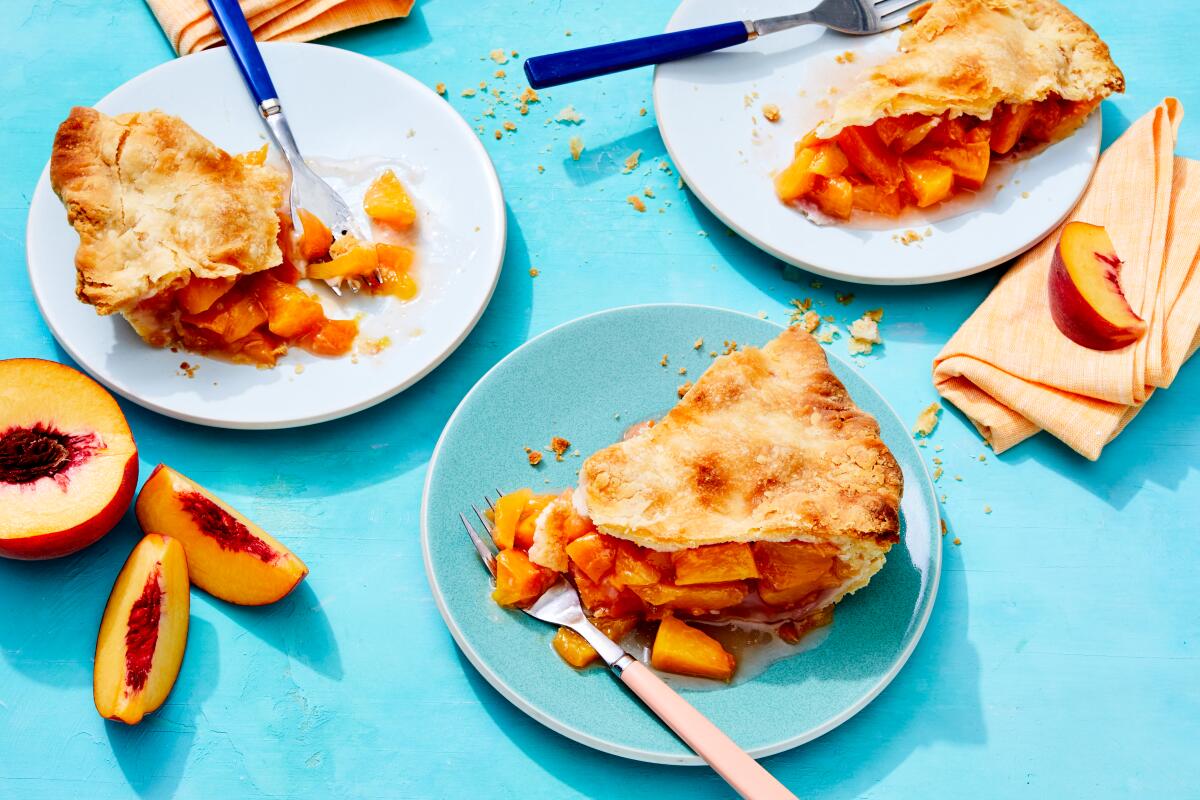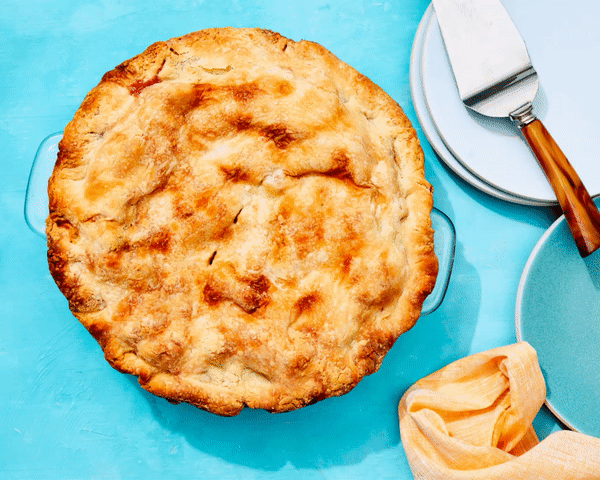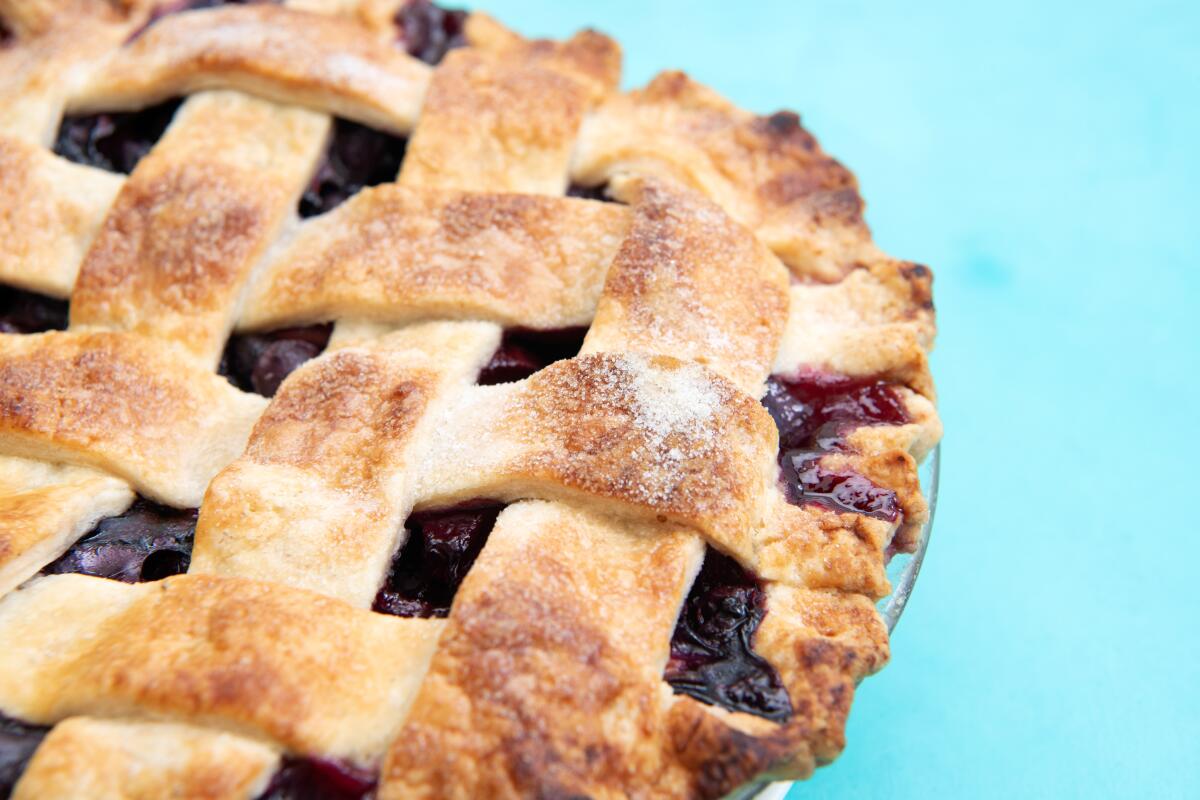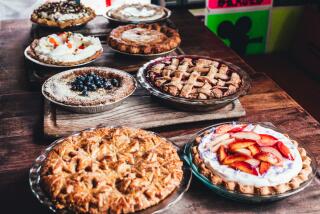Duck fat: the magic ingredient you didn’t know your peach pie needed

- Share via
Pies are my favorite dessert to bake — and eat — and I’ve experimented endlessly to achieve the perfect crust.
This dough has taken my pie game to the next level. Baking snobs (yes, I’m one of them) like to cheer, “All-butter crusts!” I’ve been there. At times, I’ve gone into the shortening camp for its flakiness and ease of rolling, but it’s never had enough flavor. Lard has been beloved now and then but often tastes too barnyard-y. The secret here is duck fat.
It’s the magic you didn’t know your pie needs.
When combined with butter, duck fat yields crackly, tissue-thin layers of pastry. The crust doesn’t taste at all gamy but does have a savory depth that butter alone can’t deliver. And thanks to fat-loving paleo-keto-type folks, shelf-stable duck fat is easy to find in stores and online. Duck fat dough is harder to roll but can be chilled to firm up at any point.
Once baked, the crust is so flaky it shatters when a fork hits it and is tender enough to slice through with a light touch. The peach filling is bound with just enough thickener so that it’s nearly saucy and not at all starchy.
It takes time and it isn’t exactly easy. But it’s worth trying because this is going to be the best pie you have this summer. Any fruit pie you make will be better than any pie from a bakery. Once pies are prepared on a commercial scale for sale, they lose the qualities that make pie exceptional.
To get the perky crimped-edge crust and tall walls of filling you see in bakery cases and on social posts, you need to squeeze the dough tight, which makes it tough, and load the filling with starch, which makes it bland at best and gloppy at worst. Better to treat the dough gently and simply sweeten the fruit.
This recipe results in a pie with a lumpy top and slouchy slices that’ll run like a freeway oil spill.
It may not be the prettiest pie, but each bite will be buttery, juicy bliss.

Peach Pie With Duck Fat Crust
2 hours plus cooling. Serves 12.
Duck fat may be liquid at room temperature. If it is, chill until it’s solid before using.
Duck Fat Crust
- 1 tablespoon granulated sugar
- 1 teaspoon fine sea salt
- 2 ¼ cups all-purpose flour, plus more for rolling
- 12 tablespoons chilled unsalted butter, cut in ½-inch cubes
- 4 tablespoons chilled duck fat, in almond-sized pieces
Peach Filling
- ¾ cup granulated sugar
- 3 tablespoons cornstarch
- ¼ teaspoon fine sea salt
- 6 large ripe but firm peaches, peeled if desired, pitted and cut into ¾-inch chunks (6 cups)
- 1 tablespoon fresh lemon juice
1. Make the crust: Mix the sugar and salt into 1/3 cup water in a liquid measuring cup until both dissolve. Freeze to chill. Meanwhile, put the flour in a large bowl. Add the butter and duck fat and toss to coat. Use your fingers to quickly press the butter and fat into the flour until flattened and the mixture resembles coarse meal with ragged clumps. Add the chilled water mixture all at once. Rake the mixture with your fingers spread wide until the dough comes together into a shaggy mass and no dry bits remain.
2. Gather the dough into two balls, one slightly larger than the other, and press into 1-inch-thick disks. Wrap each tightly in plastic wrap. Refrigerate until firm, about 1 hour.
3. Arrange a rack in the lowest position of the oven and heat the oven to 450 degrees. Flour a work surface and rolling pin. Unwrap the larger disk of dough, place on the surface, and sprinkle with flour. Roll the dough into a 12-inch round, rotating after each roll and re-flouring the surface, dough and pin as needed to prevent sticking. Gently roll the dough onto the pin, then unroll into a 9-inch regular (not deep-dish) pie dish, centering it. Gently ease the dough into the edges of the dish. Refrigerate to firm up.
4. Flour a large sheet of parchment paper and the pin again. Repeat the rolling with the smaller disk of dough, using the floured parchment as your work surface. Slide onto a baking sheet and refrigerate.
5. Make the filling: Whisk the sugar, cornstarch and salt in a large bowl. Add the peaches and lemon juice and toss until evenly coated.
6. Scrape the peach mixture into the pie dough in the dish and spread evenly. Flip the other pie dough on the parchment over the filling, centering it, then remove the parchment. Use kitchen scissors to trim the edges ½ inch beyond the dish’s rim. Gently fold the edges together and tuck them under so that they’re flush with the rim. Lightly pinch and crimp the edges as you’d like. Cut three slits in the top pie dough.
7. Line a rimmed baking sheet with parchment paper or foil. Put the pie on it, then slide onto the lowest rack of the oven. Bake until the crust is set and golden, about 30 minutes. Lower the oven temperature to 350 degrees and continue baking until the crust is golden brown and the filling is bubbling through the slits, about 45 minutes longer. If the top of the pie starts to get too dark, tent it loosely with foil.
8. Cool the pie completely on the baking sheet on a wire rack before slicing and serving.

Variations
Summer Fruit Pie
Substitute 6 cups of a mixture of ripe summer fruit, such as blueberries, blackberries, raspberries and cut nectarines, plums or apricots, for the peaches.
Lattice Fruit Pie
After rolling the top dough disk, cut it into 1-inch-wide strips. Lay half the strips across the pie in one direction. Place the remaining strips in the opposite direction, one at a time, weaving them through alternating dough strips.
Make Ahead
The dough disks can be refrigerated for up to 2 days before rolling and baking. The whole pie can be assembled and frozen for up to 3 days before baking. Bake directly from the freezer, adding 5 to 10 minutes to the final baking time.
More to Read
Eat your way across L.A.
Get our weekly Tasting Notes newsletter for reviews, news and more.
You may occasionally receive promotional content from the Los Angeles Times.











